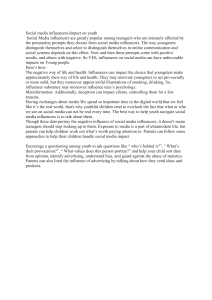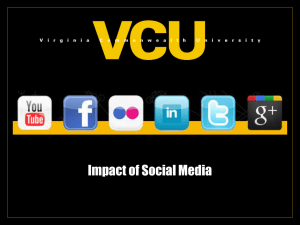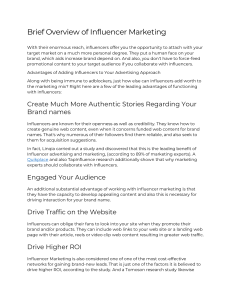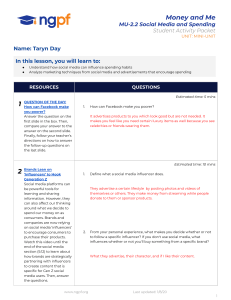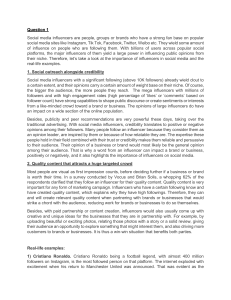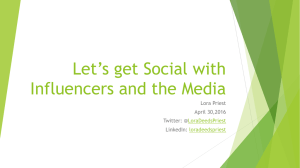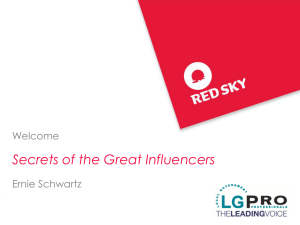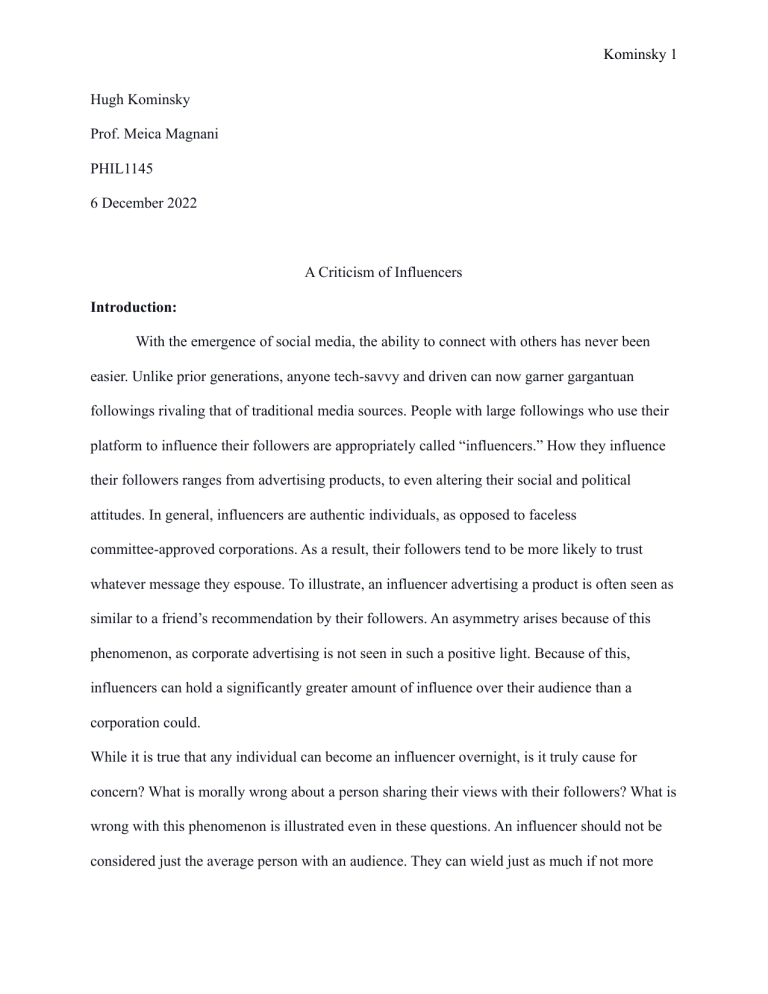
Kominsky 1 Hugh Kominsky Prof. Meica Magnani PHIL1145 6 December 2022 A Criticism of Influencers Introduction: With the emergence of social media, the ability to connect with others has never been easier. Unlike prior generations, anyone tech-savvy and driven can now garner gargantuan followings rivaling that of traditional media sources. People with large followings who use their platform to influence their followers are appropriately called “influencers.” How they influence their followers ranges from advertising products, to even altering their social and political attitudes. In general, influencers are authentic individuals, as opposed to faceless committee-approved corporations. As a result, their followers tend to be more likely to trust whatever message they espouse. To illustrate, an influencer advertising a product is often seen as similar to a friend’s recommendation by their followers. An asymmetry arises because of this phenomenon, as corporate advertising is not seen in such a positive light. Because of this, influencers can hold a significantly greater amount of influence over their audience than a corporation could. While it is true that any individual can become an influencer overnight, is it truly cause for concern? What is morally wrong about a person sharing their views with their followers? What is wrong with this phenomenon is illustrated even in these questions. An influencer should not be considered just the average person with an audience. They can wield just as much if not more Kominsky 2 influence than even powerful corporations. However, due to the perception of influencers being normal people, they can circumvent the harsh regulations and accountability employed on other sources of influence. As a result, because influencers create parasocial relationships with their fans, have the freedom to share hateful rhetoric with their followers, and turn their fanbase into echo chambers, I will be criticizing their existence and unwieldy power in the social media age. Blueprint: First, I will discuss the importance of parasocial relationships and why they are so important when discussing the unprecedented level of influence an influencer can have. After this, I will segway into a discussion of the negatives that come arise with modern influencers. In particular, I will elaborate on the point that influencers can use their influence over their followers to not just spread hateful rhetoric, but also use their fanbase to amplify the same message further. I will then explain that a part of what makes this phenomenon possible is that influencers can make their fanbases effectively serve as echo chambers by purposely delegitimizing opposing viewpoints to their own. Within these points against influencers, I will also charitably outline counterarguments in support of influencers. Parasocial Relationships: The true essence of what makes influencers so particularly potent in their ability to influence others is the inherent creation of a parasocial relationship between influencers and their follower base. Parasocial relationships are defined as “a kind of psychological relationship experienced by members of an audience in their mediated encounters with certain performers in the mass media…. Regular viewers come to feel… personalities almost as friends. Parasocial relationships psychologically resemble those of face-to-face interaction but they are of course mediated and one-sided” (Horton and Wohl 1). To connect the definition to modern influencers - Kominsky 3 followers treat influencers like a friend, despite the influencer themselves never reciprocating. As a result, influencers yield a massive amount of weight on their follower’s thoughts and actions. To illustrate, if your friend recommended you try a new menu offering at McDonald’s, you are more likely to try it than if you saw a billboard ad for the same deal. Of course, influencers aren’t the friends of their followers, but they do hold a similar level of influence, making them extremely persuasive - especially when compared to traditional forms of influence like advertisements. While this kind of influence may be tame in certain situations, certain cases can arise where parasocial relationships can be actively detrimental to not just the one involved, but also others as well. In particular, these scenarios are largely caused when an influencer uses their platform to spread some kind of hateful message. Unfavorable Influence: Unfortunately, one downside of influencer culture is that people with hateful, racist views can use their platform to spread their discriminatory rhetoric. As more and more of our public sphere moves to the digital realm, the “enhanced opportunities to engage in the public discussion also enable people to impose costs on those who bear messages they don’t like through these forms of online distraction and harassment” (Cohen and Fung 25). One of the largest drawbacks of online discussions is the ability for targetted discrimination and harassment. In particular, the most potent form of modern harassment is done by overwhelming discussion purely through strength in numbers. What allows this to occur is the movement of the dissemination of information from a one-to-many model, to a many-to-many model. The one-to-many model can be thought of as a traditional form of news broadcasting, where one centralized authority distributes information to others. However, social media has allowed for a many-to-many model - one where anyone can contribute to the discussion of information. One drawback of this Kominsky 4 though, is that there are no regulations against what any individual contributes - opening the door to people purposely spreading hateful information, or fake news. The cause of these drawbacks is the ability of large groups of people to come together with a sense of anonymity online. When these groups form, they can target harassment or share hateful rhetoric that makes the digital sphere an overall worse place to be a part of - especially if you are the target of said discrimination. Of course, this works in tandem with influencers; through the merit of the parasocial relationships cultivated by influencers, they can use their fanbases to cause targeted discrimination and harassment. However, aside from the existence of parasocial relationships, what other dynamics exist that would allow such a phenomenon to occur? One of the largest reasons why influencers can cause their followers to not just believe, but also spread their worldview is because they cultivate a fanbase that can serve as an echo chamber in and of itself. Echo Chambers: It is important to make the distinction between epistemic bubbles and echo chambers, as echo chambers are different in the fact that they actively suppress opposing arguments while epistemic bubbles occur when a group “lacks exposure to relevant information and arguments.” Because fanbases revolve around an influencer, this influencer can serve as the suppressing force against dissent. Influencers tend to cultivate fan bases that share interests and world views, and as a result, fan bases can be insular enough that they become echo chambers or forums where “members have been brought to systematically distrust all outside sources.” For example on YouTube users can ban comments with certain words or phrases, and influencers can control narratives by selectively choosing what arguments they respond to and how. These influencer echo chambers can then be used to rapidly spread fake, often hateful information that agrees with the views of the influencer and is consumed by their followers. Calling back to my previous Kominsky 5 point on parasocial relationships, the followers who will consume this media are predisposed to accept and even spread the fake information to others. To illustrate, far-right influencers such as Alex Jones can disseminate hateful, false information to his fanbase. From here, his followers will believe and then begin to further spread his message online in other forums or to people they know. Such a process is particularly concerning because it allows for influencers to have an unduly large amount of influence on many people incredibly easily. Rebuttal: Nonetheless, it is arguable that influencers don’t have enough influence to suddenly make their followers share their views. The most poignant example right now would be the case of Kanye West. Despite having a massive, loyal fanbase, his recent antisemitic remarks have thankfully been largely denounced by his fans. However, it is important to note that this may also be due to the large discrepancy between the beliefs of his fans and himself. If Kanye had a significantly more conservative fanbase, it could be argued that his antisemitic remarks would have been better received. Additionally, the points that I mentioned earlier are relevant to Kanye’s recent outbreak. For example, he began to try and make his fanbase an echo chamber by only sharing certain viewpoints and denouncing others. By doing this, for a moment in time, Kanye was able to have some of his fans with similar views to his combat people with dissenting opinions to cleanse these opinions from his fanbase. Conclusion: In this paper, I criticized the rise of modern influencers and influencer culture for numerous reasons. First, I elaborated on the concept of parasocial relationships and how influencers cultivate them. Then I expanded upon this by explaining that influencers can use the parasocial relationships they have with their fans to disseminate hateful rhetoric, create echo Kominsky 6 chambers, and influence the views of their fans. However, I did also charitably consider rebuttals to these points, namely that influencers may not have as strong of an influence on their fans to result in strong changes to their core beliefs. Works Cited Cohen, Joshua, and Archon Fung. "Democracy and the Digital Public Sphere." MIT Press, northeastern.instructure.com/courses/121545/ files?preview=18142932. Nguyen, C. Thi. "Echo Chambers and Epistemic Bubbles." Cambridge University Press, northeastern.instructure.com/courses/121545/files/ 17851159?module_item_id=8065789.’ "parasocial interaction." Oxford Reference. . . Date of access 2 Dec. 2022, <https://www.oxfordreference.com/view/10.1093/oi/authority.20110803100305809>
